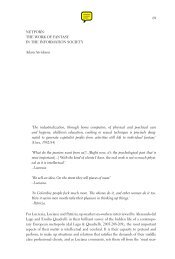Nakamura, Digitizing Race, Introduction, chapter 5, Epilogue
Nakamura, Digitizing Race, Introduction, chapter 5, Epilogue
Nakamura, Digitizing Race, Introduction, chapter 5, Epilogue
Create successful ePaper yourself
Turn your PDF publications into a flip-book with our unique Google optimized e-Paper software.
Avatars and the Visual Culture of Reproduction 141<br />
While the dolls are imbued with detailed identities right out of the box,<br />
so to speak, endowed with manufactured “memories” as are the almosthuman<br />
replicants in Blade Runner, another popular series of American Girls<br />
is marketed on the basis of its composable identity and volitional ethnicity.<br />
The American Girl Today series invites the user to “select the American<br />
Girl Today doll with the hair, eye, and skin color you like best. Each doll is<br />
18 inches tall and has a soft, huggable body with arms and legs you can<br />
pose. Her beautiful eyes open and close, and her hair is long so you can style<br />
it into all the looks you love! Your doll comes in her pretty new Go Anywhere<br />
Outfit.” There are twenty-one possible combinations, and though some<br />
of these dolls are phenotypically different from each other, no reference to<br />
race is made in any of the discourse evident on the company’s Web site or<br />
paper catalogs. Though straight hair is simply described by color, such as<br />
“honey blond,” and by the word “curly” if the hair is “light,” the dark curly<br />
hair evident on the “dark” doll is dubbed “textured.” Kapsalis notes the language<br />
of modularity evident in the company’s discourse that stresses the<br />
interactivity of the act of purchasing one of these dolls, an act that is overtly<br />
figured as creative and reproductive in the sense that the buyer is steered toward<br />
an act of visual self-replication: “The catalog encourages girls to pick<br />
dolls that look like them, selecting skin, hair, and eye color as close as possible<br />
to their own.” So while the character dolls are made to represent<br />
specific types of ethnic and national “others,” American Girl Today dolls<br />
create a representational landscape that replicates the discourse of reproductive<br />
technology, one that promises to help mothers create babies that<br />
look like them. While both “reborn” dolls and American Girl dolls are part<br />
of the material culture that is derided by the tasteful parents described in<br />
articles about designer nurseries and diaper bags, classified no doubt as examples<br />
of the “plastic junk” that the Pfeiffers and Michael Ryan dismiss as<br />
“not smart,” and definitely not something that “our mothers” would consider<br />
chic, what is notable about this discourse is the way that it figures<br />
reborners and American Girl doll enthusiasts as “hobbyists” and “collectors.”<br />
These are both terms associated with creativity, but in a way that is<br />
distinctly gendered, and in a way that still stresses consumption and selection<br />
rather than creation and design. Michael Ryan and the Pfeiffers are described<br />
as designers and entrepreneurs, partly because of their financial success (as<br />
mentioned earlier, reborn and American Girl dolls generate a great deal of<br />
revenue in both primary and secondary markets), but mainly because of the<br />
way that their work is credited as “original” creation, because of their class





